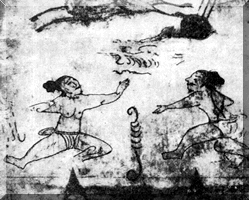
PASSPORT WORLD TOUR - Summer 2024 SOUTH KOREA
Posted: August 06, 2024
WHERE IN THE WORLD
South Korea, officially the Republic of Korea is a sovereign state in the southern part of the Korean Peninsula. The name “Korea” is derived from Goryeo, a dynasty which ruled in the Middle Ages. South Korea lies in the north temperate zone with a predominantly mountainous terrain. It covers a total area of 99,392 square kilometers and has a population of almost 50 million. The capital and largest city is Seoul, with a population of 9,794,304.
WHAT KIND OF KARATE? TAE KWON DO
Tae Kwon Do: In Korean, tae means “to strike or break with foot”; kwon means “to strike or break with fist”; and do means “way”, “method”, or “path”. Thus, taekwondo may be loosely translated as “the way of the hand and the foot.”
The art in general emphasizes kicks thrown from a mobile stance, employing the leg’s greater reach and power (compared to the arm). Taekwondo training generally includes a system of blocks, kicks, punches, and open-handed strikes and may also include various take-downs or sweeps, throws, and joint locks. Some taekwondo instructors also incorporate the use of pressure points, as well as grabbing self-defense techniques borrowed from other martial arts, such as hapkido and judo.
 ORIGIN
ORIGIN
The oldest Korean martial art was an amalgamation of unarmed combat styles developed by the three rival Korean Kingdoms of Goguryeo, Silla, and Baekje, where young men were trained in unarmed combat techniques to develop strength, speed, and survival skills. The most popular of these techniques was subak, with taekkyeon being the most popular of the segments of subak. Those who demonstrated strong natural aptitude were selected as trainees in the new special warrior corps, called the Hwarang. Their military training included an extensive weapons program involving swordsmanship and archery.
During the Japanese occupation of Korea (1910–1945), all facets of ethnic Korean identity were banned, including Korean martial arts. During the occupation, Korean Japanese martial artists were exposed to martial arts in China and Manchuria. When the occupation ended in 1945, Korean martial arts schools (kwans) began to open in Korea under various influences. Some believe taekwondo was derived from native Korean martial arts with influences from neighboring countries.
In 1952, during the Korean War, there was a martial arts exhibition in one demonstration, Nam Tae Hi smashed 13 roof tiles with a punch. Following this, South Korean President Syngman Rhee instructed martial arts be introduced to the Korean army. By the mid-1950s, nine kwans had emerged. Rhee ordered that the various schools unify under a single system. The name “taekwondo” was accepted on April 11, 1955 training and one’s own creative efforts.”
As it stands today, the nine kwans are the founders of taekwondo, though not all the kwans used the name.